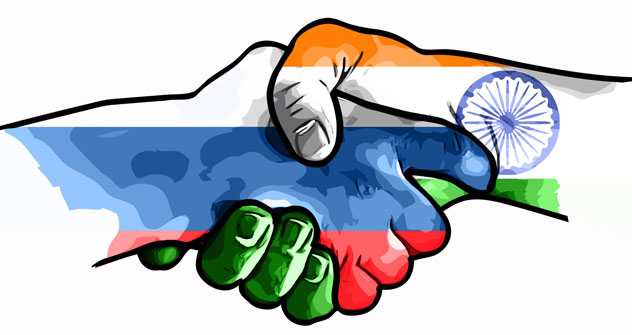
70 years of India-Russia Relations : A Bilateral Bond that Binds 2 Super Powers
Date:

Share post:
Since 1947, India has enjoyed close diplomatic relations with Russia for mutually beneficial partnerships. Russia, formerly known as the Soviet Union has been contributing to India’s economic growth by investing in India’s key sectors like defence, education, mining, heavy machine-building, steel, and energy production. In fact during India’s second Five Year Plan (1956-1961) that focused on heavy industry, 8 out of 16 heavy industry projects were initiated with the Soviet Union. The India Russia ties further strengthened when in August 1971, the Indian Prime Minister Indira Gandhi signed the India-Soviet Treaty of Peace, Friendship and Cooperation for global peace and security. Then again with the dissolution of the Soviet Union, India entered into two new treaties with Russia – Treaty of Friendship and Cooperation (1993) and the Military-Technical Cooperation Agreement (1994). Russia even today continues to be an important ally of India. After the recent India-China clash over the Galwan Valley, Ladakh, it was Moscow that initiated a trilateral peace meet between the foreign ministers of Russia, India, and China on June 23, 2020.
Celebrating 70 years of India-Russia relations
In 2017, to celebrate the 70th anniversary of diplomatic relations between the two countries, Prime Minister Shri Narendra Modi was invited as the Guest of Honour at the St. Petersburg International Economic Forum. During the same time at the 18th Annual Bilateral Summit the St. Petersburg Declaration: Vision for the 21st Century was signed by the two countries with 12 Agreements to consolidate economic and political ties.
The countries have set up two institutions. They are,
– The Inter-Governmental Commission on Trade, Economic, Scientific, Technological and Cultural Cooperation (IRIGC-TEC), co-chaired by the External Affairs Minister of India and the Deputy Prime Minister of Russia, and
– The Inter-Governmental Commission on Military and Military Technical Cooperation (IRIGC-MTC) co-chaired by the Defence Ministers of both countries.
Both these institutions identify investment opportunities and review cooperation between the countries regularly.
Where does India Russia connect?

Defence Sector
Defence cooperation is one of the strongest pillars of the India-Russia partnership. The projects include a supply of MiG-29-K aircrafts, supply of Kamkov-31, and Mi-17 helicopters. Another crucial partnership is the BrahMos joint venture between India’s DRDO and NPO Mashinostroyenia (NPOM) of Russia for the development and manufacture of indigenous cruise missiles for the Indian army.

Nuclear Power
The flagship joint nuclear power project is between Russia’s Rosatom State Atomic Energy Corporation and Kudankulum nuclear power plant (KKNPP), Tamil Nadu. The partnership aims to build 12 nuclear plants in India over the next 20 years. Russia is also collaborating with India in the manufacture of a nuclear-powered submarine. What is further remarkable is that Russian technology and Indian expertise together participated to set up a nuclear plant in Bangladesh –Rooppur Nuclear Power Project.
S&T Cooperation
In 1972, India and USSR signed the Science and Technology Agreement and in 1987, they signed the Integrated Long Term Programme (ILTP) of scientific cooperation. Further, in 2017 a high-level Science and Technology Commission was established. It helped to set up Russia-India network of Universities and to contribute to different aspects of technology, one of them jointly contributing towards research cooperation in the Arctic region. Besides, several institutionalized bilateral programs are carried out in biotechnology, medical sciences, meteorology, and oceanology.

Economic growth
India and Russia are working towards achieving a target of USD 30 billion each way in bilateral trade by 2025, from about USD 9.4 billion in 2017. A meeting between Prime Minister Narendra Modi and President Vladimir Putin in 2018 at Sochi accelerated the economic partnership in – space, defence, politics, civil nuclear energy, and anti-terrorism cooperation.

Culture
On one hand, while Indian students are learning about Russian literature through the works of Leo Tolstoy and Alexander Pushkin, Russian scholars like Gerasim Lebedev and Nicholas Roerich visited India to study Indian culture and philosophy. The grand epic of India, Mahabharata, too has been translated into Russian.
And who can forget the influence of Bollywood on Russia? Generations of Russians have been fans of Indian cinema. Even Russian ballet dancers and ice-skaters perform to well-known Bollywood tunes.
Yoga in Russia has been growing and becoming increasingly popular since the 1980s, particularly in majors cities and urban centres.

Tourism
2018 was celebrated as the ‘Year of Tourism’ between India and Russia. Though there is an average of about 100,000 Indians visiting Russia every year, the Russian Tourism Ministry will be launching on January 1, 2021, eVisas to facilitate Indian visitors to visit Russia.
Regional and International Cooperation
India and Russia as members cooperate closely at – United Nations, BRICS, G-20 ASEAN and East Asia Summit Forum. In 2017, Russia backed India to get a membership to the Shanghai Cooperation Organisation (SCO). Both countries continue to share similar views on fighting terrorism, cybersecurity, preventing weaponization of outer space, and the prevention of weapons of mass destruction.
As relations strengthen
The St. Petersburg Declaration of June 2017 between India and Russia states, “advancing the comprehensive development of the Indian-Russian relations is an absolute priority of the foreign policy of both States. We will continue to widen our scope of cooperation by launching large-scale initiatives in different spheres and enhance and enrich our bilateral agenda to make it more result-oriented.”.
It continues further, “As relations strengthen, India and Russia are identifying several new areas of cooperation in the areas of deep sea exploration, robotics and artificial intelligence, skill development, agriculture, and railways. In addition, both countries want to deepen their ties at the ground level too by promoting healthier connectivity and cooperation between the younger generations and in the cultural sphere.
The bilateral bond and friendship between the two superpowers is only expected to get stronger from here….
